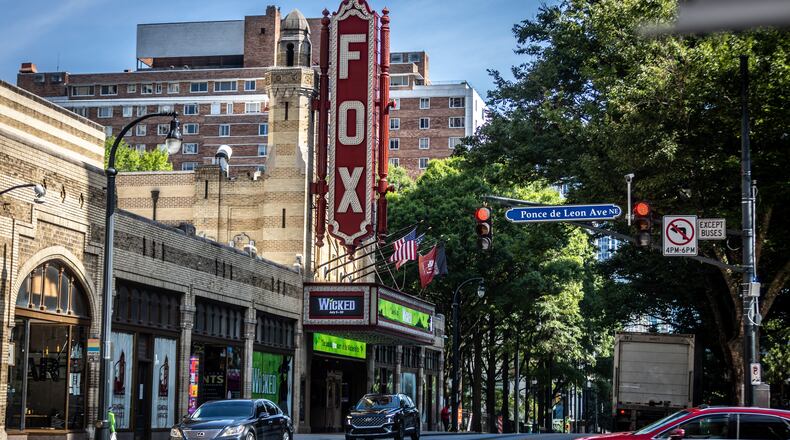On any day, dozens of people hustle between coffee shops, condo buildings and convenience stores along Midtown’s stretch of Peachtree Street.
Pedestrians share the bustling corridor of cracked asphalt with a steady flow of cars and delivery trucks, the traffic noise from all blending with the cacophony of construction from nearby buildings.
The Midtown Alliance, the nonprofit representing the area’s business and community interests, wants to re-evaluate and re-imagine Peachtree Street from 10th Street to North Avenue — from the iconic Margaret Mitchell House to the historic Fox Theatre. The proposal, announced last week, aims to keep Peachtree Street one of Atlanta’s most-used corridors by balancing vehicular needs with pedestrian-friendly infrastructure.
Dan Hourigan, Midtown Alliance’s director of transportation and sustainability, said community input will play a large role in the scope of the project and final conclusions. No idea is too small, he said.
“We’re encouraging people to think big,” he told The Atlanta Journal-Constitution. “We are trying not to get caught up in the minutiae. We want big ideas.”
Those ideas could vary from reducing the four traffic lanes to make way for more bike and scooter access to widening sidewalks for more outdoor restaurant seating. While Hourigan said everything is on the table, Midtown Alliance does expect the plan to focus primarily on making the 0.75-mile corridor “more people-focused and less vehicular-focused.”
That’s a mission that is welcome to some of the area’s landmark establishments.
“We would love for the environment in and around the theatre to be as easy to navigate and easy to walk as possible,” said Allan Vella, president and CEO of the Fox Theatre.
Credit: Michael Blackshire
Credit: Michael Blackshire
Peachtree Street is not only a fixture of Atlanta, but it’s also an economic driver. Midtown Alliance said the road connects $19 billion of economic development and activity from downtown to Buckhead, encompassing everything from Underground Atlanta to Lenox Square Mall.
For many people, the corridor is home.
James Hughey took a late-morning stroll Monday near his condo, although he would’ve loved to take his bike for a spin if he felt it was a wise choice.
“I don’t like biking in the city because I don’t feel safe,” said Hughey, who has lived in Midtown since 2019.
Atlanta does have some dedicated bike infrastructure, but few have protective barriers. Hughey said more investment in alternative modes of transportation, from scooters to MARTA, would help encourage more people to opt for something other than their cars.
Hourigan said there’s data to back up that perspective. According to the Georgia Department of Transportation, traffic counts have declined along Peachtree Street, decreasing more than 5% from 2018 to 2022.
“What benefits Midtown is we have a street grid, we have MARTA and we have people that live and work here,” he said. “You’ve got more options of how to get around, and I think those things together explain why traffic hasn’t buried us over the last 20 years as we’ve grown.”
A 2022 Midtown Community Survey with 3,520 participants found more than 40% of respondents wanted wider sidewalks, additional bikes lanes and infrastructure to reduce vehicle speeds.
Egbert Perry, the chairman of developer Integral Group, said corridors like Peachtree Street are the spine of an urban community and lay the groundwork for smart development projects.
“You need to make it easy for people to traverse the land and go from node to node,” he said. “The minute you recognize that opportunity, you just created huge development potential in between those two nodes.”
The land surrounding the Margaret Mitchell House, the 1899 home where “Gone with the Wind” was penned, is the focus of some of that development attention. Trammell Crow Company is currently building a 30-story tower adjacent to the historic landmark.
Proposals for road diets, in which lanes are removed for other uses, have proven controversial in some areas, though transportation experts say that narrower streets at slower speeds are safer for motorists and pedestrians. That, in turn, can boost street activity.
“The conversation really needs to start with, ‘What are we trying to connect, and what are we trying to connect people to?’” said Perry, who was co-chair of the Peachtree Corridor Task Force in the mid-2000s to evaluate the full 14.5-mile thoroughfare.
Credit: Michael Blackshire
Credit: Michael Blackshire
Midtown Alliance is working with engineering consultant Kimley-Horn and global design firm Snøhetta, which worked with New York City to incorporate new pedestrian spaces along Broadway in Times Square. The organizations aim to have an implementation plan by the end of October, detailing next steps, potential projects and concept renderings.
The city of Atlanta allocated $4.85 million to Peachtree Street improvements in Midtown through the Transportation Special Purpose Local Option Sales Tax (TSPLOST) that voters approved last year. Hourigan said those funds would help implement the plan’s eventual projects.
While Peachtree Street doesn’t share the Big Apple’s scale, it does serve as an inspiration for taking a busy urban center and improving it, Hourigan said.
“It’s got a really strong foundation to start from, but it can be so much more,” he said. “It should be so much more. It should inspire, not just be good.”
Credit: arvin.temkar@ajc.com
Credit: arvin.temkar@ajc.com
About the Author
Keep Reading
The Latest
Featured


